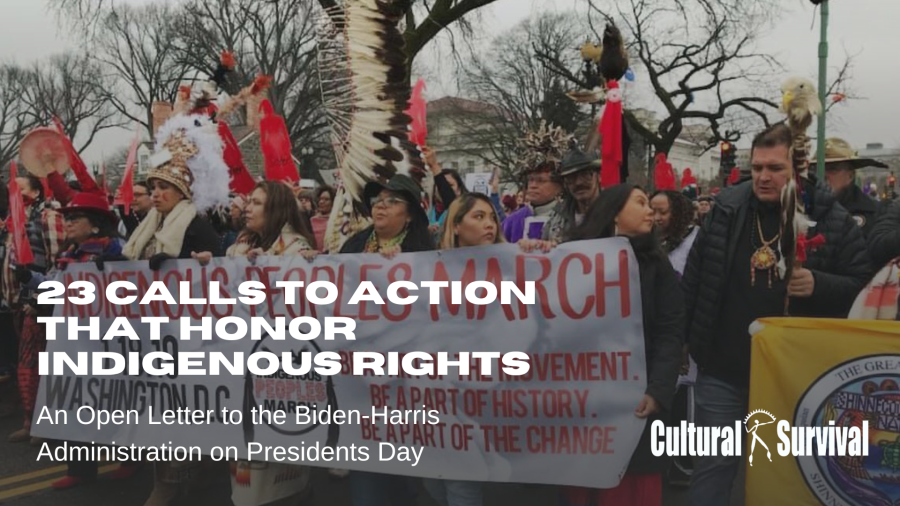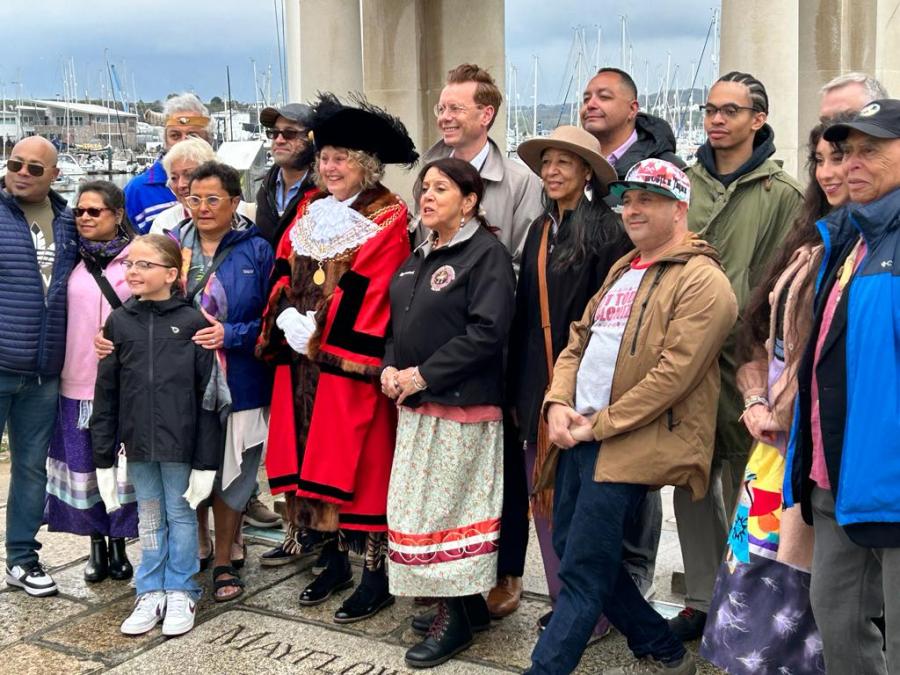In the 1800s the U.S. government designated what is now Oklahoma as Indian Territory and began moving tribes from other areas to the territory to make way for white expansion. That history gives the state a unique position: it has more Indian tribes than any other state and thus more languages at risk.
Oklahoma’s unique history as Indian Territory has caused it to end up with an amazing variety of tribes and languages. Some of the tribes now here were already in the area, or ranged through here, at the time of first European contact (Osage, Tonkawa, Caddo, Comanche, Kiowa). Others were brought here on their various “Trails of Tears” from the 1820s to the 1870s. First the southeastern tribes—Choctaws, Cherokees, Creeks, Chickasaws, Yuchis, and Seminoles—were sent here to make room for white ambitions in their homelands. Then, through a multitude of treaties and “agreements,” more tribes were brought from the northwest, north, northeast, and the south. This is how Oklahoma came to have 37 federally recognized tribes.
When I first came to Oklahoma, I was teaching an undergraduate course in beginning linguistics at Oklahoma State University. When I announced one day that the next class would cover the languages of Oklahoma, half the class broke into laughter. “Did I say something funny?” I asked. “Well, Oklahoma,” someone said, “that’s English, right?” After I named a few of the Indian languages of the state and expressed amazement that the students were unaware of them, another student commented, “We knew we had Indians, but we didn’t know any of them spoke their languages.”
In some cases Oklahoma tribes are related to remnants of their original tribes who remained in the old homeland or groups that branched off to other locations (so there are Cherokees in North Carolina, Seminoles in Florida, Cheyennes in Montana, Arapahoes in Wyoming, Kickapoos in Mexico, etc.). In most cases, however, the group within Oklahoma constitutes the whole historic tribe. Many Oklahoma Indians are thoroughly assimilated into a more or less “Oklahoma” culture and language, if not identity; they engage in the same major pursuits and occupations as non-Indians; they speak English; they dress and look pretty much like most of their neighbors and drive the same cars and pickups; they are outwardly distinguishable only by their physical features or non-mainstream-sounding surnames. Some feel part of the mainstream; most are somewhat Indian-identified; some are angry and feel marginalized; a few are still culturally traditional. Very few still speak their heritage language.
A lot of Oklahoma Indians are in denial about this emergency. Once, when the Intertribal Wordpath Society (IWS) set up a table at the Red Earth festival in Oklahoma City, many young Oklahoma Indians came by, looked at our chart of the language situation, and said we had it wrong, that their tribe had many more speakers than we were showing. I wish that they had been right. At least they wanted there to be speakers. But they must face the fact that if their youngest speakers are in their 70s, their language has maybe 20 years left unless drastic steps are taken to produce new speakers immediately. The young need to get busy with language revitalization. We have produced a mug at IWS that says in Creek: “Vhonecvs ce! [Wake up!] Save your language!”
Critical Issues for Oklahoma Indian Languages Today
One of the biggest challenges to Native American language revitalization in Oklahoma is assimilation. “Oklahoma” means “Indian” (in Choctaw okla means “people” and homma means “red”), and Oklahoma is a very Indian place, which is in many ways positive. But there is also a down side to “Indianess” when tribes assimilate into an undifferentiated mass of intertribal “Indians,” as opposed to Choctaws, Wyandottes, and Arapahoes. The signs of this conglomerate self-identification are everywhere: the adoption of “Aho!” (originally a Ponca men’s greeting, but now a greeting, thank-you, and multipurpose Indian-identifier used by Comanches, Cheyenne women, and many more), and the spread of the stomp dance (formerly unique to southeastern tribes) and the gourd dance (begun by the Kiowas) to tribes that previously never had them.
Cultural borrowing is not bad in and of itself; the danger is that when tribes adopt the ways of others, they forget their own. When they get an identity through intertribal culture, preserving their own tribal ways may take a back seat. And then there is the most common assimilation: to the ways of the majority culture and the English language to the exclusion of native language. There’s nothing wrong with everyone speaking English. But it is a sad and unnecessary loss for young Indians to grow up speaking only English: think how much richer they would be if they spoke English plus their heritage language.
Another huge issue is time. In most Oklahoma tribes, there are few, if any, fluent speakers below the age of 70. In several tribes, all the speakers could die this year. I often advise tribes with fewer than a hundred speakers to consider this when planning elders’ field trips and the like. I tell them, “Don’t put all your speakers on one bus!”
These blunt facts must be faced. More than 96 percent of Oklahoma Indians are not fluent in their tribal language. And the speakers who are lost are not being replaced. At the current rate of speaker replacement, there will likely be no more than four or five Indian languages left by 2030.
Tribes not only need to make language revitalization a high priority; they need to make it happen. Tribal budget makers too often consider other needs, such as roads, housing, or social services, as more critical than language revitalization. I wonder if the increased pride and self-respect that could come from language revitalization wouldn’t help with problems like drugs and alcohol, which are hitting many Indian communities hard.
Another issue is what I call “habitat.” Conservation biologists study the concept of island biogeography, in which a small plot of jungle amid a sea of ranches or urban areas can still support wildlife. The phenomenon depends partly on the distance between these island niches. Something similar is important to language survival. Because Oklahoma native language communities are mostly gone, there are few, if any, places where learners can put their language to use in a natural setting. And with the original tribal communities broken up into individual allotments and often interrupted by non-Indian holdings, the distance between speakers can be great. Language revitalization programs need to figure out how to recreate language communities. Some have set up immersion weekends or immersion weeks as occasional events, but they need to think in terms of ongoing opportunities to hear and practice the language in everyday life.
There are other practical issues that have slowed language revitalization in Oklahoma: the physical infirmity of fluent speakers, disagreements over which dialect to choose as the standard, and who the best speakers are. Then there are politics and personal issues. With so much at stake, leaders need to come forward who can overcome the problems or work around those that cannot be overcome.
What Works
When I first came to Oklahoma, all the language activities I heard about involved classes of adults that met once a week to go through lists of vocabulary and translate things that students wanted to know how to say. This does not lead to fluency, and fortunately this situation is changing.
What works is immersion, both in the classroom and in small, personal, master-apprentice arrangements. (The master-apprentice model of language learning as developed among California tribes classically involves one fluent teacher and one younger learner who live their lives together intensively and solely in the language for 20 or more hours per week. The apprentice can become fully fluent after about three years of this. Variations on the model have involved two masters or a family of apprentices.)
Intense, frequent learning periods work. Combining language and culture works. Creating a habitat for the language is essential. Fortunately, more and more Oklahoma language programs are now heading in these directions.
Current Efforts
There is increasing Indian language awareness and promotion by mainstream institutions in Oklahoma. The University of Oklahoma has been offering Indian language courses for college credit since the early 1990s. Current offerings include Choctaw, Cherokee, Creek, and Kiowa at three levels for credit, all taught by members of the respective tribes. Northeastern State University in Tahlequah offers classes in Cherokee and teacher training for Cherokee instructors. The University of Oklahoma’s Sam Noble Oklahoma Museum of Natural History has just held its fifth annual Native American Youth Language Fair, which helps Indian children from all over the state see the value of achievement in their own language by offering them a public stage, as well as prizes, certificates, and t-shirts.
While these institutional programs are welcome and helpful, efforts by tribes and individuals in the communities are the most elements for developing fluency and revitalizing language habitat. More and more Oklahoma tribes,like the Choctaws, Comanches, Cherokees, and Pawnees, are beginning to commit their own funds to language work. The Cherokees are running immersion preschools and the Yuchis have introduced language programs in their preschools; a Sauk immersion program is also under development. The Cherokee Nation offers online classes, and the Yuchis are developing computerized activities and CDs. The Choctaw tribe has set up Choctaw language classes in more than 40 public schools. Even tribes like the Miami and Kaw, whose languages have no surviving fluent speakers in the state, have active language programs. They make use of written sources and consult with linguists and speakers of related languages and, where possible, fluent speakers in other states or Canada. The Kaws have their own tribal linguist.
The Kiwat Hasinay Foundation, a nonprofit organization dedicated to Caddo language, has held classes; collected, digitized, and archived old song and language recordings; and produced publications such as a bilingual children’s storybook and a Caddo language phrasebook. There also are individuals within the Miami, Comanche, Yuchi, Pawnee, Kickapoo, Creek, Sac and Fox, Kiowa, Chickasaw, Ponca, and Osage tribes offering language classes and starting other programs for their people.
This is just a small sample of the exciting language work going on in Oklahoma. But there is still not enough, and many of these are not immersion programs. What is needed immediately is a realistic understanding of the urgency of language endangerment, money (for training, transportation, supplies, and salaries), some technical know-how, and the leadership and determination to overcome the difficulties and work together for the future of Oklahoma’s irreplaceable Indian heritage. The recent surge in interest, and the great enthusiasm and creativity of language workers are all very good signs. But a real future for Oklahoma languages—not as books or videos on a shelf, but as living, breathing, functional languages—requires massive, immediate language teaching, and the building of new language habitats.
Alice Anderton is the executive director of the Intertribal Wordpath Society, a not-for-profit organization that promotes Oklahoma Indian languages. Among its many public activities the organization produces Wordpath, a weekly 30-minute public-access television show about Oklahoma Indian languages. For more information on the society, go to www.ahalenia.com/iws



